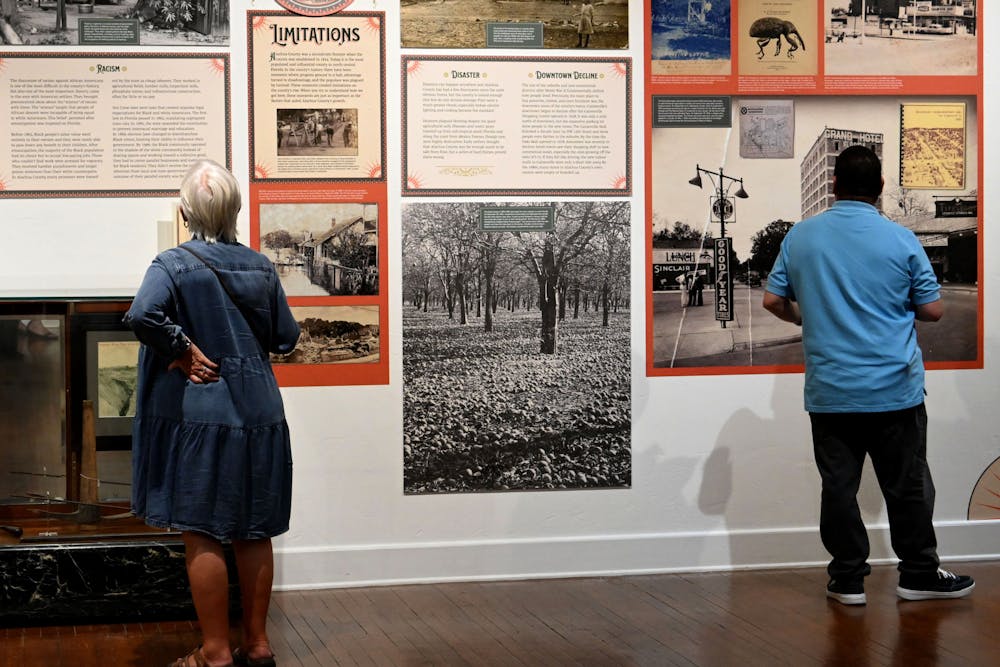Correction: This story has been updated to reflect Terrence Ho's proper title.
The Matheson History Museum hosted the opening reception for "Refugee Resettlement in Gainesville" Thursday night. The mini-exhibit highlights the path to resettlement for six families.
Terrence Ho, a 38-year-old artist and refugee resettlement director at the Greater Gainesville International Center, approached the museum about showcasing his artwork that depicts refugee journeys from their arrival to building a life in Gainesville.
Ho said his close collaboration with refugees after a January executive order dissolved refugee admission programs inspired him to share his artwork.
Refugee struggles have only grown more challenging with the loss of government funding. The order has left programs like the GGIC without the majority of their financial support, which will inhibit the aid refugees receive for their resettlement.
“We don’t feel like a refugee has to prove over and over again, ‘Yes, I have trauma,’” Ho said. “They are worth being a human being because they are a human being. They’ve already asked for help, so we’re going to help them.”
The drawings are reflections of the real-life scenes Ho witnessed every day, he said. The exhibit highlights the steps refugees must take to assimilate into American society, like medical screenings, interviews and English classes.
“It’s all the different things they have to go through,” Ho said. “It’s not supposed to be a sob story, or a success story or anything.”
His black-ink sketch style was loosely inspired by Chinese calligraphy, he said. Each drawing included a description outlining exactly what was happening when the image was captured.
The exhibit can be read in a winding figure-eight, with sections titled: Pre-arrival Planning, Arrival, Identification, Benefits, Intake Meeting, Health, Housing, School and English Classes, Cultural and Physical Orientation.

Dianne Vinson, a retired teacher who visited the exhibit, found one piece especially realistic. It looked like a graphic novel, Vinson said.
“There was one wonderful picture that showed the kids getting bored during an interview,” she said. “I thought that was really perfect.”
Her biggest takeaway from the exhibit, she said, was that people have no idea how complicated it is to seek refuge in America. Americans are ignorant of how lucky they are, she said.
The GGIC supports refugees and their families as they settle into a new community. Ho is one of two workers employed at the organization. The rest of the staff is made up of volunteers.
Steve Kalishman, a GGIC board member, attended the exhibit’s opening reception. He worked closely with Ho on the resettlement project.
All resettlement programs, including the GGIC, lost their funding the day the current administration took office in January, he said.
Now, GGIC relies on donor and sponsorship contributions to continue its work. Kalishman said the organization will survive the shift, but immigrants awaiting visas or other aid will suffer from the new policy.
“We feel like it's something that is still valuable that needs to be done, so we are going to help people as much as we can,” Kalishman said.
The Matheson History Museum recognizes the importance of preserving history and showcasing works from local artists. Executive Director of the Matheson History Museum Salvatore Cumella said the museum would love to work with Ho on future exhibitions.
“We really love his unique way of capturing local history through a unique medium,” Cumella said.
A digital exhibit of Ho’s artwork is set to be displayed at the Gainesville Fine Arts Association at the end of July.

Contact Isis Snow at isnow@alligator.org. Follow her on X @snow_isisUF

Isis is a junior sports journalism student and is the volleyball beat reporter for fall 2025. This is her third semester with The Alligator. She enjoys reading, playing basketball and weight lifting in her free time.






